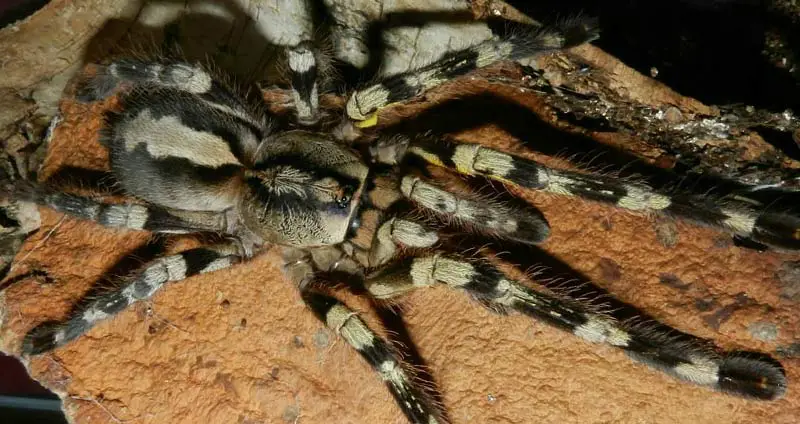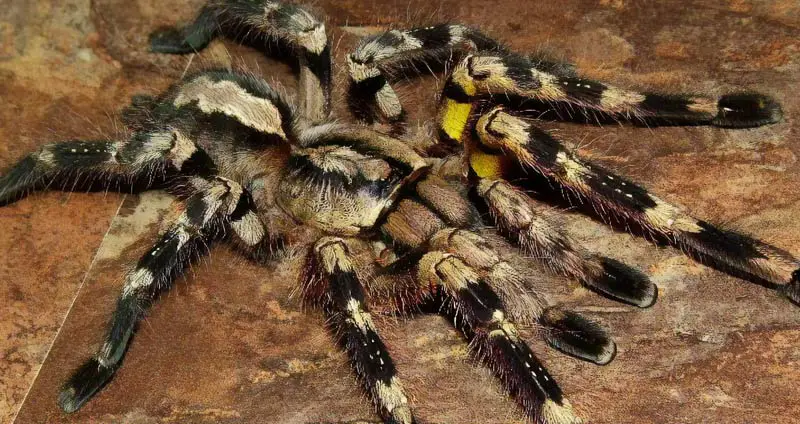There are tarantulas out there for people of every skill level. Some tarantulas, like Avicularia avicularia are among the easiest to care for and most easy-going species. However, others are exist on the opposite end of the spectrum — moving incredibly quick and delivering a terrible bite if threatened. This tarantula, Poecilotheria fasciata, comfortably sits at that end of the spectrum.
Whether you’re interested in learning more about the Sri Lankan Ornamental Tarantula or if you’re looking into bringing one home in the near future, definitely read on. This care sheet will go in depth about what exactly makes this tarantula so sought-after yet so dangerous.
Table of Contents
Poecilotheria fasciata Care Sheet
| | |
Common Name |
Sri Lanka Ornamental |
Species Type |
Old world arboreal |
Natural Habitat |
Found in the hot and humid climate of Sri Lanka. Takes residence in trees, hiding in bark, leaves, and their own webs. |
Growth Rate |
Fast growth rate. Females and males can reach full size within 3 years. |
Adult Size |
Females reach a legspan of between 7″ and 8″, with males measuring slightly smaller. |
Lifespan |
Females regularly live 11-12 years, while males often only live 2-3 years. |
Enclosure |
The enclosure should be taller than it is wide, with plenty of materials to climb on and attach webbing to. Two inches of substrate should line the floor, and water should always be available. Since this is a larger tarantula, a large enclosure is also required. |
Temp/Humidity |
78°F to 82°F with about 65% to 75% humidity. |
Diet |
Fantastic eater that can eat around 5 adult-sized crickets per week. Mealworms and a couple dubia roaches can be used as a supplemental food. |
Temperament |
Not necessarily an aggressive or defensive tarantula, but will likely bite if provoked. Quite fast-moving and unpredictable at times. |
Experience Level |
Intermediate – Not a very difficult tarantula to care for, but it can be dangerous to be around if you aren’t sure how to interact with old world tarantulas. |
Average Cost |
Slings ~ $40, Males ~ $80, Females ~ $100+ |
Poecilotheria fasciata Appearance
The appearance of these tarantulas is what draws most people to them initially. They have seemingly cryptic black, grey, and white markings all over their body that immediately make them stand out. The carapace has two black lines running down the middle of it that continue down through the abdomen.
The first and second pairs of legs possess similar markings which includes yellow bands near the base. The third and fourth pairs of legs have bluish-gray femurs. Overall, this mess of colors and patterns makes for a very impressive tarantula that’s unrivaled by most other species.
In terms of size, Poecilotheria fasciata is quite impressive there, too. Females grow to have a legspan between 7 and 8 inches, while males are a bit smaller. This species reaches that legspan in quite an impressive time, too. Some owners have noted their specimens growing 3 inches in just one year — that’s fast!
As spiderlings, these tarantulas are cute but definitely not as impressive. They’re born just under an inch and have very muted colors but still display the patterns that adults have.


via @andrei_tropikanec / Instagram
Poecilotheria fasciata Temperament
Unfortunately, with a great physical appearance comes a pretty difficult personality. This tarantula is no joke! In fact, I’ve personally seen multiple new-ish tarantula owners discouraged from owning this tarantula by more experienced owners. It’s very important to know what you’re getting into by purchasing P. fasciata.
Sri Lanka Ornamental Tarantulas are old world tarantulas, which are known for their more aggressive personalities, very painful bites, and their preference to fight over taking flight in the face of danger. It’s this unfriendly disposition that makes them unsuitable for new or inexperienced tarantula owners.
One world that accurately describes Poecilotheria fasciata is speed. This is an insanely fast moving spider from its early sling stage to its mature adult stage. They will move very quickly if they perceive a nearby threat or if they see an opening in their enclosure that they want to escape from. Fortunately, they’re not really a defensive species that throws up threat poses frequently, but they still can be aggressive.
One benefit of this temperament is that it’s an interesting tarantula to watch. It spends a good amount of time exploring its enclosure and puts on a great show during feeding. If you have the skills necessary to keep it happy, you’ll be rewarded with an entertaining specimen.
Watch Out For Venom
As stated, this is a tarantula that has very potent venom that causes lots of pain to the victim. Various bite reports state that a Poecilotheria fasciata bite results in nausea, vomiting, and muscle and joint stiffness for two weeks. There aren’t many other tarantula species that pack such a devastating punch!
To avoid weeks of agony, it’s recommended that you don’t handle this tarantula at all. Make your interactions with it brief and distant. Only access the enclosure when it’s absolutely needed, and use tweezers to place food into the enclosure.
Since this is such a fast species, they can react and bite before you have a chance to comprehend what’s happening. Always err on the side of caution!
Housing Poecilotheria fasciata
If you’re going to bring home one of these tarantulas for your collection, you need to already have an enclosure set up that meets all of their needs. Since these tarantulas are so skittish and fast, you should aim to build an enclosure that doesn’t require much intervention in the future.
The conditions of the enclosure should be similar to this species’ natural environment. As the name suggests, they hail from Sri Lanka, which has a very hot and humid climate due to it being located on the equator. Therefore, optimal temperatures sit around 80°F with an optimal humidity level of about 70%.
Optimal Enclosure
While Poecilotheria fasciata does have specific environmental needs, it’s not a difficult task to meet those needs. To begin with, this is an arboreal tarantula that spends most of its time above the ground within its webbing or taking shelter behind a hide. Therefore, their enclosure should be built to meet the needs of an arboreal tarantula.
This is a very large species, so their enclosure needs to be larger than your average tarantula. This Exo Terra 18″x18″x24″ vertical enclosure would provide enough space for a fully-grown specimen to move around, hunt, and create a safe habitat for itself. It has good breathability, accessibility, and visibility — all things that are very important in a tarantula enclosure.
The inside of the enclosure needs to be well-decorated for an arboreal tarantula. This includes layering about 2 inches of substrate on the ground, then using fake plants, sticks, and even a cork bark hide to create a vertical environment that’s easy to climb and anchor webbing to.
It’s also very important to include a water bowl at the bottom of the enclosure. While you may not see tarantulas drink, they actually do use water bowls as a fresh source of water. It also helps to maintain humidity within the enclosure.
Always be sure to closely monitor the temperature and humidity of the enclosure. Heat lamps or space heaters can be used to bring the enclosure up to a suitable temperature, especially in the winter. Additionally, spraying down the enclosure with water once a week and thoroughly moistening the substrate once a month will prevent humidity from dropping too low.
Poecilotheria fasciata Diet
These are large and aggressive tarantulas, and they have a ravenous appetite to match. Owners are able to feed them a wide variety of different foods including dubia roaches, crickets, and even geckos and pinky mice on occasion.
While spiderlings aren’t incredibly small, they should still be fed different food. Quarter-inch crickets fed twice a week is suitable for young slings. Then, as they age, they can be transitioned into eating a total of 5 adult crickets per week. Two dubia roaches can be fed instead if you want some diversity in their diet.
As stated, this species is a fantastic eater. Placing a cricket in the enclosure will result in P. fasciata quickly running down onto the enclosure floor and subduing its prey. If it doesn’t eat immediately, don’t worry! It will be sure to eat when it’s hungry. Make sure that food is always available in this case.
Health Issues
While the Sri Lanka Ornamental Tarantula is hard to care for because of its temperament, it doesn’t have many health problems that make it hard to care for. They’re quite hardy and will thrive when housed and fed accordingly. All captive tarantulas run the risk of experiencing dehydration and mites/parasites, but both of those problems are easily avoided and dealt with.
You should note two things when it comes to this species. To begin with, this is a true arboreal, so it absolutely needs to be able to spend lots of time above the ground. If you prevent Poecilotheria fasciata from climbing and building webs up high, it may result in stress that can drastically reduce the lifespan of your specimen.
Additionally, it’s possible that every tarantula can run into problems with its molt. However, as long as temperature and humidity are kept at optimal levels, the chances of this happening are quite low.
If your tarantula’s molt gets stuck, you’ll need to help them finish it. Although this can be dangerous, there are many guides online that will walk you through helping your large and dangerous tarantula complete their molt.
Purchasing Poecilotheria fasciata
Due to the fact that this tarantula is so visually-appealing and sought-after by quite a few tarantula enthusiasts, it tends to fetch a decently high price. It’s quite rare to find one being sold these days, so expect to pay a pretty penny to bring home even an unsexed spiderling.
While there were several online marketplaces and breeders that sold this species, that’s not so much the case anymore. The fact that the Poecilotheria genus is being considered endangered has made these creatures difficult to sell/purchase across state lines. Unsexed slings can fetch $50, while adults (especially females) easily reach $100+.
If you can find and secure one of these tarantulas, though, you’ll be making a great addition to your collection. Only experienced tarantula keepers should have one of these, so don’t be too hasty with purchasing one. However, once you’re ready, $100 for such a visually-stunning and fun tarantula is quite a small price to pay.


